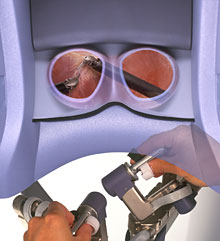Summer 2009: Of Note

rise of the machine: Surgeon John Pattaras says the da Vinci robot reduces patients’ recovery time.
Kay Hinton

©2009 Intuitive Surgical Inc.
I, Robot
The Da Vinci Surgical System is changing the face of surgery
Da Vinci at a glance
The da Vinci Surgical System (yes, the name is a nod to Leonardo, who designed the first robot) was approved for select surgeries by the Food and Drug Administration in 2000 and costs about $1.8 million. More than one thousand da Vinci robots are now in use around the country. Emory University Hospital acquired its da Vinci system in 2008. Below: the surgeon sees in 3-D through a stereoscopic viewer; a depiction of the da Vinci system set up for a patient.
By Mary J. Loftus
In this spring’s season finale of Grey’s Anatomy, Chief of Surgery Richard Webber—in a bid to keep his chief resident from a prestigious pediatric fellowship—buys the hospital something he knows will lure Dr. Miranda Bailey back to general surgery: the da Vinci HD robotic surgical system.
“Care to take it out for a spin?” Webber asks Bailey, to her obvious delight.
On a recent May morning, a similar scene is taking place in an Emory University Hospital operating room. Associate Professor of Urology John Pattaras, director of Minimally Invasive Surgery, is prepping for two back-to-back surgeries using the state-of-the-art da Vinci robot—and colleagues who will be assisting him seem every bit as captivated by the high-tech tool as the fictional doctors of Seattle Grace.
Pattaras’s first surgery of the day involves the reconstruction of a congenital blockage of a kidney (pyeloplasty); his second is the removal of a cancerous prostate (prostatectomy).
Wearing a Washington Redskins scrub cap, Pattaras makes small marks on the patient’s stomach, indicating where the incisions will be. “Is he relaxed all the way?” he asks the anesthesiologist. He then makes four keyhole incisions, inserting a hollow cylindrical port into each.
“Bring in . . . the robot,” Pattaras intones, clearly enjoying the moment.
Surgeons from the Department of Urology use the da Vinci system frequently, averaging three to four robotic surgeries per week, with prostatectomies being the most common. Emory cardiac surgeons are performing single-vessel coronary artery bypass grafting with the da Vinci as well, and several other departments have used the robot for a variety of cases.
This morning, Pattaras is tutoring Assistant Professor of Urology Nedra Hood on the da Vinci; she will soon use the robot to correct female incontinence in her patients.
Pattaras’s team wheels over da Vinci’s large mechanical base, positioning its four interactive arms strategically over the patient’s midsection and attaching each arm to a port. The da Vinci’s arms hold an endoscopic camera and, as needed, scissors and graspers. A fourth port allows a member of the surgical team to assist manually in the operation.
As the miniature camera, which has its own light source and relays three-dimensional, high-definition images to the surgeon’s console, is guided down one of the ports and into the patient’s abdomen, it produces a soft glow. The patient’s abdominal cavity is inflated with CO2 gas to provide more space for working and viewing.
After making sure the da Vinci is correctly attached, a nurse dims the lights, and Elvis begins to sing “All Shook Up” from Pattaras’s Creative Zen MP3 player in the corner. Pattaras sits down, unscrubbed, at the da Vinci’s surgical console a few feet to the left of the patient.
“The table doesn’t move after the robot is in place,” he says, reminding everyone in the room that precision is critical. And then, looking down through the console’s viewport at a magnified image of his patient’s internal pathways and organs, Pattaras begins the operation—hands moving fluidly beneath the viewer, maneuvering controls that translate his actions into parallel movements by the robotic arms.
It’s an odd sight, initially, to see the robot in action, metallic arms flexing rapidly over the patient’s body. Were it not viewed in the context of a present-day OR, the da Vinci would seem to be a strange, multilegged mechanical creature straight out of a science fiction film. The color monitor above the patient’s head, however, reassuringly displays the finely tuned actions taking place within the patient’s body. The surgeon, not the robot, is in complete control.
Pattaras guides dual instruments—a scissor and a grasper—through the small quarter-inch ports, moving the intestines out of the way to allow access to the swollen left kidney, which was not draining properly. He makes careful, steady progress, pushing organs and tissue aside.
He uses the scissors not only to cut but to cauterize tissue. Pressing a foot pedal can make the instruments hot enough to seal off small bleeds, an action that is often accompanied by a puff of smoke. Another foot pedal allows Pattaras to move the camera, adjusting his line of vision. By switching instruments to needle drivers on the robotic arms, he can perform the precise suturing necessary for the reconstruction.
The kidney surgery is over in a few hours. The ports are removed and Pattaras begins stitching up the patient’s four incisions. “With the da Vinci, patients heal faster, and there’s less bleeding and downtime,” he says. For instance, this surgery would have required a “shark bite” of an incision had it been performed through traditional open methods, Pattaras says, and recovery would have taken months instead of days or weeks.
“We are just at the beginning of robotic surgery,” says Pattaras, as the upbeat tempo of the B-52s’ “Love Shack” fills the room and he begins prepping his next patient.